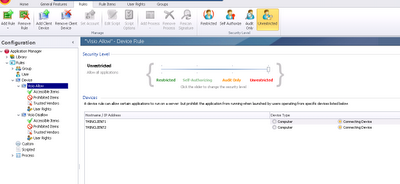Particularly in Citrix/RDS environments, the licensing models for applications like Microsoft Visio and Project can quickly become unreasonable. These applications are often only required by a small subset of users, yet they are licensed by Microsoft on a per-device basis. This means that every user device able to access the application – be this a thin client, PC, laptop, PDA, mobile phone or tablet – requires a separate license.
A common misconception associated with this model is the belief that by limiting the application delivery to a small set of users – say, for instance, an Active Directory security group – that they will become compliant with Microsoft’s licensing rules. This is not true. The per-device licensing model is exactly as it states, and every user device that can access the Remote Desktop Services/XenApp server with the software installed requires a license – regardless of whether they can actually run it. Even using Group Policy objects such as Software Restriction Policies does not signal compliance, as these are user-level, not device-level, controls. Although it may seem rather inflexible, the reasoning behind this licensing model is easy to grasp. Controlling access via, for instance, group memberships is something that could be easily subverted, whether intentionally or not. Even hosted virtual desktop solutions or use of streaming software such as App-V cannot guarantee complying with the per-device rules.
However, Microsoft have verified that per-device licensing in this method can be controlled using AppSense Application Manager device control. AppSense AM uses a kernel filter driver that intercepts all file execution requests. The launch can then be allowed or denied based around various configurable rules. This includes a restriction by device name or IP address, allowing a compliant control to be applied for the Microsoft per-device licensing rules.
Take, for example, a company with Microsoft Visio installed on a XenApp 6.5 infrastructure and 1800 users with thin client machines. This application is only used by 70 users but as the servers with the app installed can be accessed from any thin client machine, the company must purchase 1800 licenses for Visio – 1730 more than will actually be using the application, making a mockery of the cost-savings associated with their XenApp and thin client infrastructure.
However, AppSense AM controls access to visio.exe based around client device names, restricting the amount of thin clients that can physically run the application and complying with the per-device licensing rules. If additional clients require access to Visio, their details can be added to the device rule when more licenses have been purchased. Another additional feature is the capability to run Application Manager in passive mode, allowing details on application usage to be monitored and giving the company an idea of how many licenses they may need to purchase.



